Gardening for wildlife
The Butterfly Diaries
It was a childhood wish of mine to have a secret garden all to myself. I did realise the dream when I was much older and the garden I had then was not quite secret. Despite this, it contained a secret world which was invisible to all who passed through or
passed by but was always available to me whenever I wanted to place the cares of office behind and was ever a source of delight and fascination.

As gardens go, it was a slip of one, hardly 20 yards by 25 yards, just large enough to form the facade of the small two-roomed bungalow in the desert of Jaisalmer where I lived. Indeed it had only a single tree, a patch of grass, some creepers on the fence
and a few potted plants but it was peopled by creatures who gave me small glimpses of their lives.
My day begins early, the "ploonk plink" of bulbuls and the "caw caw caw" of the crows is infinitely preferable to waking up with the help of an alarm clock. It is just after dawn, the sky is still grey as the sun has not risen over the dunes at the horizon
and the breeze which blows across the sand is still cold. The last vestiges of night-life can occasionally still be seen. Today, a flicker of movement at the corner of my eye causes me to turn my head, just in time to catch a last glimpse of the tail of the
large desert monitor (Varanus griseus) who lives behind my bungalow in a hole amidst a tangle of barbed wire. He has a regular nocturnal beat at this time of the year which takes him through the matchbox-sized gardens of the three bungalows side-by-side, then
around the large store-house, into the transport yard, across the bordering dune, and back along it on the far side till he rounds the dune, crosses a road and is back into the tiny gardens.
Sometimes, late at night I find a large, prickly and wicked looking arthropod, the solifuge, who patrols my garden each night for insects and small life. Of him, I have written elsewhere.
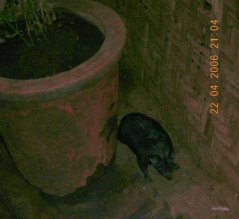
The hedgehog creeps by at night
About him and the Varanus, the hedgehog does not know or care, for about once a fortnight, he pays me a visit.
It is always dark when he comes for a sip of water from the squirrel-bowl. He easily finds his way in but for some reason stumbles on his way out and so I notice him. He scrambles between the bowl and fence but there is no exit there. He tries the jird's hole
but I lift him and place him on the road outside my bungalow free to go where he wills.
He is easily trapped, and since taking a good picture is difficult, so one day, I catch him and keep him till day-time when I photograph him.
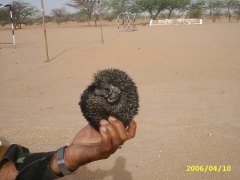
Hedgehog held in hand peeps out
Hedgehogs are difficult to identify and my guides are not quite comprehensive and the descriptions not specific enough, so, like a lot of amateur naturalists, I call it an Indian Hedgehog and leave it at that.
Night too leaves behind a few small villains, who now appear or can be found where they were not present the previous evening. I am referring, of course, to the scorpions who have the knack of turning up where you never expected to find it - on the outside
of the 'macchar-dani' (mosquito net), in the folds of the towel on the rack, three feet above the ground or in your boots, the one day you forget to check. Then, its a ''EEYOWW' followed by the immediate,abrupt and merciless extinction of the perpetrator and
later on a local anaesthetic and some salve. A few bites later, you realise it was the fright and unexpectedness which raced your heart more than the pain and it was your ego that required the balm more than the sting.
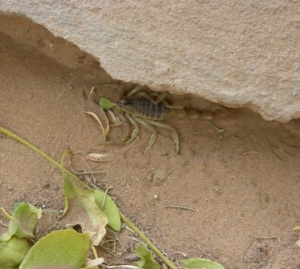
"Curses"discovered again!
|
Gardening for wildlife
(Contd from last month)
The Butterfly Diaries
Fortunately, I have never found, horror of horrors, the arch-villain, in my shoes or garden - the saw-scaled viper. I'm sure he must be there for my garden is fenced with old duck-boards standing upright, but I never saw him. Nearby yes, but never in my garden.
But lets put these night-time experiences away, for the sun has peeped over the dunes. At this time, strangely, it is not the birds that draw you but the bees. For my garden boasted two hives of bees. They appeared almost together one year after the winter
had passed. The largest was in the tree and belonged to Apis florea, Dwarf Honey Bee. The second hive in the thatch of my garden fence behind a bamboo 'patti' screen was the hive of Apis cerana, the Asiatic honeybee. For a brief period these hives flourished,
each oblivious of the other, and just as suddenly died out in the autumn. But while they were there, the humming of bees around the sunlit portulacas gave an almost-ethereal feeling to me drowsing in my plastic garden-chair under the tree.
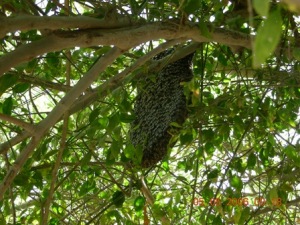
The hive in the tree! (Apis florea)

The hive in the thatch. (Apis cerana)
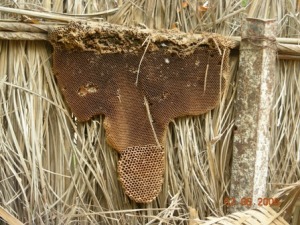
The abandoned thatch hive exposed. Never imagined it to be so large!
The authorities pipe water twice a day, once in the early morning and once after dark. So in between these times, you are dependent on water in the roof tanks and stored water in the bathroom buckets. Water is life in the deserts. The pipeline supplying the
garden has a small leak at the place where it bends around the garden corner and there it leaks. Each morning, the garden creatures are treated for an hour or so to a thin lamellar flow across a patch of cemented pavement. I have forbidden its repair so that
the creatures can get their small but just desserts!
The bees buzz here across the garden from the hive , and like teenagers wearing many pocketed jeans, they pick up water in the small cups or satchels on their legs and take off for the hive. I imagine this water is used to keep the queen and the larvae air-conditioned
through the summer. The bees drink greedily of this water and long after it has stopped they crowd the fence, pipe, wet gravel and moist soil with an unquenchable appetite.
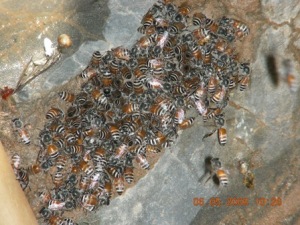
Its not just humans who store water each day!
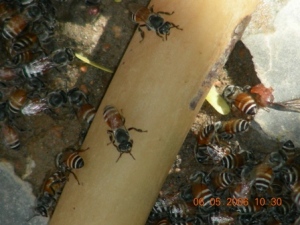
The bees crawl everywhere to get at the water. (Apis cerana)
Seeing this and the fact that their presence kept some small creatures away I added two more sources of water. A pot of water hung from a tree branch for the birds and bees and a earthen water-bowl for the squirrels, jirds and other creatures at ground level.
Since I was watering them, I decided to feed them, so I added a small wooden feeding tray. The carpenter was so gratified at being asked to do so noble a task that of his own he added a bird-house to the tray. I did'nt have the heart to put him right but gave
him an extra shabash! Anyway, the bees now started raiding the water-pot in the mid-morning and afternoons too!
-(To be continued)
|